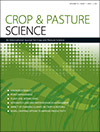Wheat is one of the most widely grown crops in the world and salinity and drought are major abiotic stresses affecting wheat production in the world, in particular in Iran. We identified main- and epistatic-effect quantitative trait loci (QTLs) for 15 traits in wheat, and found 61 main-effect QTLs on 15 chromosomes and 21 epistatic interactions on 12 chromosomes. Candidate genes were identified within QTL regions that directly or indirectly play a vital role in the germination and early seedling stages under salt-stress conditions.

Crop and Pasture Science
Volume 72 Number 1 2021
B-BOX (BBX) proteins are important transcription factors involved in the regulation of plant growth and development. In this study, 96 BBX genes were identified from wheat by using bioinformatics-based methods, and the functions of TaBBX genes were verified by qPCR and preliminarily studied. Gene-family analysis was found to be a systematic and comprehensive method of analysing a class of genes and screening those with the strongest expression and regulation capabilities for further research.
As an alternative to monocultures, cultivar mixtures can reduce the risk of yield losses caused by climate change; hence, we studied mixed canopies of wild-type and early-maturing accessions of two cultivars of rice. There was no significant yield difference per unit area between the monoculture and mixed culture, but lodging tolerance increased in the mixed canopy. Our mixture of accessions with different maturity dates improved lodging tolerance of the mixed planting with no effect on productivity.
Soybean cyst nematode (SCN) is a common soybean disease worldwide. We identified the potential resistance mechanism of soybean variety Kangxian 2 to soybean cyst nematode HG Type 0, and found some metabolic pathways that were specifically expressed in the syncytial initiation and establishment stages. The findings provide a new research direction for the development Kangxian 2, and a reference for breeding new SCN-resistant varieties and mining resistant SCN genes.
CP20198Growth of Megathyrsus maximus cv. Mombaça as affected by grazing strategies and environmental seasonality. I. Tillering dynamics and population stability
 , Marina Castro Uebele, Guilhermo Francklin de Souza Congio, Roberta Aparecida Carnevalli and André Fischer Sbrissia
, Marina Castro Uebele, Guilhermo Francklin de Souza Congio, Roberta Aparecida Carnevalli and André Fischer Sbrissia
Herbage production is an important feature of pastoral systems of animal production because it determines stocking rate. Herbage production depends on the turnover of tillers, and on the turnover of tissues on living tillers. This is the first of two companion papers that deal separately with tiller and tissue turnover, providing complementary strategic knowledge for defining grazing management targets for Mombaça guineagrass (Megathyrsus maximus cv. Mombaça).
CP20199Growth of Megathyrsus maximus cv. Mombaça as affected by grazing strategies and environmental seasonality. II. Dynamics of herbage accumulation

Herbage production is an important feature of pastoral systems of animal production because it determines stocking rate. Herbage production depends on the turnover of tillers and on the turnover of tissues on living tillers. This is the second of two companion papers that deal separately with tiller and tissue turnover, providing complementary strategic knowledge for defining grazing management targets for Mombaça guineagrass (Megathyrsus maximus cv. Mombaça).
Increased flooding of saltland pastures is expected to occur with climate change; therefore, we evaluated tolerance of tall fescue under waterlogging, salinity and their combination, including a recovery phase. Tall fescue proved more tolerant to waterlogging than to salinity, with the effect of the combined stress not as detrimental as expected. High inter-cultivar variability was found, most evident for root growth, which can be useful for breeding purposes and further research into the tolerance mechanisms involved.



